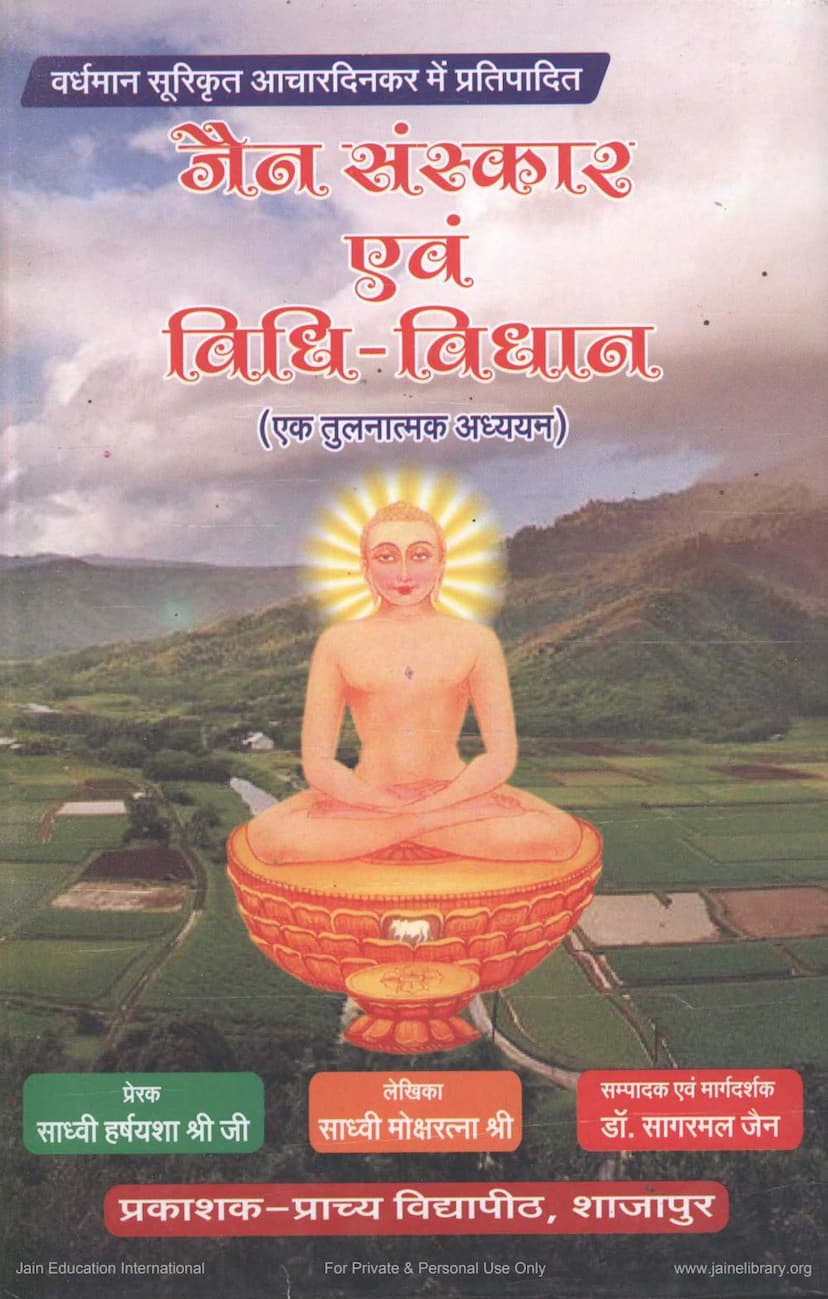Jain Sanskar Evam Vidhi Vidhan
Added to library: September 2, 2025

Summary
This is a comprehensive summary of the Jain text "Jain Sanskar Evam Vidhi Vidhan" by Sadhvi Mokshratnashri, as reflected in the provided pages:
Title: Jain Sanskar Evam Vidhi Vidhan (Jain Rituals and Regulations)
Author: Sadhvi Mokshratnashri
Publisher: Prachya Vidyapith, Shajapur
Inspiration/Guidance: Sadhvi Harshayashashriji (Inspirational Acharya), Dr. Sagarmal Jain (Editor and Guide)
Dedication: The book is respectfully dedicated to the revered spiritual lineage and esteemed guiding figures of Jain tradition, including Dada Shri Jindattasuri, Dada Shri Jinkushalsuri, Pravartini Shri Tilakshriji M.Sa., and Mahattara Shri Vinita Shriji M. Sa., expressing profound gratitude for their blessings and inspiration.
Core Subject: The book is a comparative and critical study of Jain rituals (Sanskar) and regulations (Vidhi Vidhan) as presented in the "Achardinkar" authored by Vardhmansuri.
Key Aspects of the Book:
- Academic Foundation: The book is based on a research thesis approved by Jain Vishva Bharti Institute for a Ph.D.
- Focus on "Achardinkar": The central theme revolves around the extensive work of Vardhmansuri, "Achardinkar," which meticulously details various Jain rituals and regulations.
- Total Sanskars Covered: "Achardinkar" is presented as detailing a total of 40 Sanskars:
- 16 Sanskars for the householder (Grihastha).
- 16 Sanskars for ascetics (Yati).
- 8 general Sanskars applicable to both.
- Comparative Study: A significant aspect of the book is its comparative analysis of Jain rituals with those found in Hindu traditions and the Digambara Jain tradition.
- Definition and Significance of Sanskar: The book delves into the etymology and multiple meanings of the word "Sanskar" across various philosophical schools (Mimansa, Advaita Vedanta, Nyaya, Bauddha). It highlights that in Sanskrit literature, "Sanskar" can refer to education, culture, training, refinement, purification, religious ceremonies, and the process of improvement or enhancement. The most appropriate English equivalent is identified as "Sacrament." Generally, a Sanskar is defined as an act or ritual that makes a person or object qualified for a specific purpose.
- Purpose and Importance of Sanskars: The text explores the purpose of Sanskars, which generally aim to:
- Counteract negative influences.
- Attract positive influences.
- Facilitate physical and spiritual purification.
- Enhance personality and social development.
- Provide cultural continuity.
- Achieve spiritual growth and worldly prosperity.
- Instill moral values and awareness of social responsibilities.
- Historical Context of Sanskars: The book touches upon the origins of Sanskars, suggesting they arose from a belief in divine influences that could affect life, leading to efforts to mitigate negative and attract beneficial ones.
- Jain vs. Other Traditions: It notes that while rituals exist in various forms across religions, Jain tradition distinguishes its approach by focusing on internal purification and spiritual refinement.
- Number of Sanskars: The book acknowledges differing views on the number of Sanskars across traditions:
- Agamdinakar (Shvetambara): 40 Sanskars (16 householder, 16 ascetic, 8 general).
- Adipurana (Digambara): Over 108 Sanskars (categorized as 53 for conception, 48 for initiation, 7 for actions).
- Vedic Tradition: Significant variation, with numbers ranging from 16 to 18, or 40, and mentions of 11, 13, or 18 in various Grihyasutras and Smritis. The concept of 16 Sanskars became prominent later.
- Contribution of "Achardinkar": The book emphasizes that "Achardinkar" is a pivotal work within Shvetambara literature for its comprehensive and detailed exposition of 40 Sanskars, including specific rituals for householders and ascetics, which was not as thoroughly covered in earlier Shvetambara works like "Panchashak-Prakaran" or "Nirvanakalika" (which primarily focused on ascetic rituals). It is considered a unique contribution for its detailed explanation of the "how, when, and why" of each ritual, making it accessible to laypeople.
- Vardhmansuri's Work: The book highlights Vardhmansuri as a learned Jain Acharya, well-versed in Sanskrit and Prakrit, who drew upon scriptural references. His work is estimated to be around 12,500 verses and is divided into two volumes.
- Research Methodology: The book is structured into seven chapters, systematically presenting the concept of Sanskar, related literature, Vardhmansuri's personality and contributions, detailed analysis of householder Sanskars, ascetic Sanskars, general Sanskars, and a concluding assessment of their relevance.
- Originality of Research: The author stresses the originality of the research, noting that the topic of Sanskars within Jain literature was previously under-researched. The translation and detailed analysis of "Achardinkar" are presented as a novel contribution to Jain scholarship.
Structure of the Research Work (Seven Chapters):
- Introduction: Definition, purpose, significance, and comparative enumeration of Sanskars across traditions.
- Literature Related to Sanskars: A presentation of literature from Hindu, Digambara, and Shvetambara traditions concerning Sanskars.
- Vardhmansuri's Personality and Work: An exploration of Vardhmansuri's life, his textual contributions, and a comparative and critical study of the Sanskars detailed in "Achardinkar."
- Householder Sanskars in "Achardinkar": Detailed discussion and comparative analysis of the 16 householder Sanskars.
- Ascetic Sanskars in "Achardinkar": Detailed discussion and comparative analysis of the 16 ascetic Sanskars.
- General Sanskars in "Achardinkar": Elaboration and comparative analysis of the 8 general Sanskars for both householders and ascetics.
- Conclusion: An assessment of the value of the described Sanskars and their relevance in contemporary times.
Overall Objective: The book aims to provide a scholarly and comparative understanding of Jain rituals and regulations, as codified by Vardhmansuri in "Achardinkar," situating them within the broader context of Indian religious traditions. It highlights the meticulous detail and practical guidance offered in "Achardinkar" for both lay followers and ascetics.